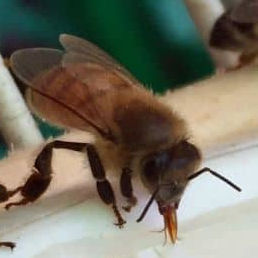
Now we are approaching September we need to consider feeding our bees to ensure they have enough stores to last till next spring. Also varroa treatments should be complete by now or well under way. If Apistan or Apivar were used they should be removed after 6/8 weeks and that should be in this month. This is all part of preparing bees for winter.
Before I feed my colonies I like to check that each one looks viable. A quick inspection is made to ensure there is a laying queen and she has a good size nest. If the colony looks weaker compared to other colonies then it is worth considering uniting weak ones as long as there are no signs of disease. Chalk brood is very easy to identify whereas other brood diseases are less so. Any colony with bad chalk brood is culled this time of year as it is too late to rectify the situation. This is the last opportunity to inspect bees for six months so it is important they are in as good a state as possible.
Those colonies that look viable I feed as quickly as possible and I use Ambrosia. Syrup made from white granulated sugar is fine but it should be as strong a solution as possible, that is two parts sugar to one part water. Recently I have bought English tray feeders as the lids on contact feeders break down after a few years. Hopefully the tray feeders will last a lot longer.
If a colony was artificially swarmed earlier in the year check that all the frames with foundation have been drawn. If there are one or two frames undrawn by the walls bees sometimes leave these alone when being fed. Bring the frames into the edge of the nest which encourages bees to draw them when being fed. The sooner this is done the better as bees are less inclined to draw comb the further we move into autumn. If some frames are not drawn it means bees will not have enough space for the stores you intend to feed.
It is important to continuously feed a colony until it has enough stores; around 45lbs or 22kgs. If there is a break in feeding some of the stores will be turned into brood which means they will not have as many stores as you might think. But don’t overfeed as bees will fill cells where bees have emerged and thereby prevent the queen laying as many eggs she needs to produce the winter workforce. If feeding takes place too late in the year the outside temperature may be low and bees form a cluster. They don’t process syrup properly in these conditions and may leave the water content too high which can result with stores fermenting. This can cause dysentery in the hive and loss of bees.
When feeding bees all colonies in the apiary should be fed at the same time as bees become excited by the sudden input of food. If syrup is spilt or frames with honey are left open It can trigger robbing. An eke should be placed over the crown board around the feeder so the roof can be replaced. In fact I cover the feed holes with the feeder in order to prevent robbers gaining access through any gaps under the roof.
My aim is finish feeding by the end of September and hopefully before the ivy starts to flower. Some apiary sites have an abundant source of ivy in the autumn. Over the years I have found that bees that have collected a lot of ivy honey can have problems during winter, mainly with dysentery. So to avoid too much ivy being stored in the brood box I aim to finish feeding by end of September. A super is then returned to the hive for the bees to store any crop they may gather. The supers are then removed in November and any honey is dealt with then. Sometimes there is none at all and others there are several frames. It all depends on the weather conditions, ivy availability and strength of the colony. Some people really like the flavour but it is quite strong and is a ‘Marmite’ honey – you either like or you don’t!
Regards
Wally
